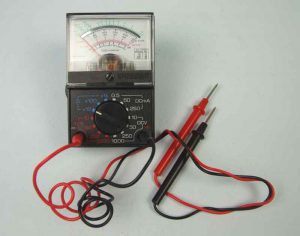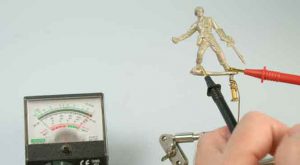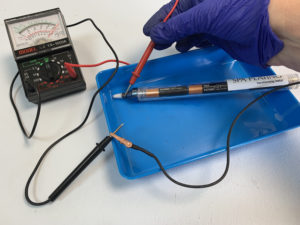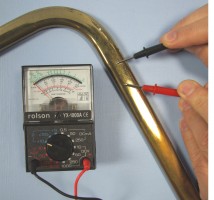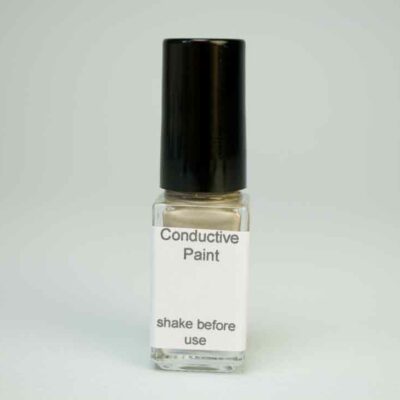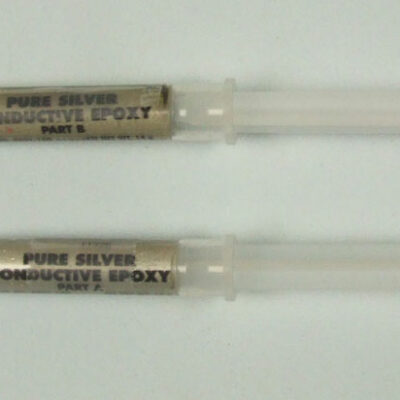We customise our Conductivity Testers by gold plating their probes. This greatly increases their efficiency and helps to prevent puncturing through the delicate conductive silver ink layers in preparation for plating on non-conducting items. Each one is fitted with Duracell batteries for long-life.
Conductivity Tester
£21.49 + VAT
The Conductivity Tester is essential for checking that your Conductive Ink (hi-grade) or Conductive Paint layer has been applied correctly and you have good conductivity across the surface of your work before plating or electroforming. Please hold the gold plated probes in the way shown in the picture; they only need to gently rest against the conductive ink as it is a very delicate layer and can be easily punctured. We customise our Conductivity Testers by gold plating the probes but if you are using a different conductivity tester we strongly recommend you gold plate its probes before you use it, particularly if you are using conductive paint or ink.
Here the conductivity tester is being used to test the output from the batteries in our battery powered plating pen.
The Conductivity Tester is a very useful addition to your kit, whatever kind of plating you intend to carry out. It can be used to test the conductivity of all surfaces and is particularly useful when checking if the metal surface you’re trying to plate is covered with an invisible layer of varnish, which will inhibit plating. To see more about using our Conductivity Tester, please click HERE for our Electroplating Manual.
The conductivity tester being used to check the circuit on our battery operated plating pen.
Back to Product Description
| Features | Benefits |
| Tests conductivity of metal | Detecting if there is any invisible varnish on the surface of the metal you are going to plate, which will make the surface non-conductive and prevent plating.If the needle clearly moves, then it is conductive and you can go ahead with your plating. |
| Tests conductivity of Conductive Paint (hi-grade) with gold plated probes | When plating onto non-conductive materials, it’s important to make sure the layer of Conductive Ink you’ve sprayed on is conductive with this Conductivity Tester. We customise the probes of the Conductivity Tester for you, by gold plating them.This ensures there’s a good electrical contact between the probes and the layer of Conductive Ink and means you only have to very lightly rest the probes against the surface to get a reading. This is very useful as the Conductive Ink layer is delicate and can be easily punctured when touched too roughly. |
How to use our Conductivity Tester
Before you try to plate the surface of your work, find out whether it will conduct electricity and is therefor e able to be plated, by using our Conductivity Tester. It may save you a lot of time and effort!
Our Conductivity Tester is vital for plating on plastics and other non-conductive surfaces as you may need to test if the layer of our Conductive Ink (hi-grade) you've sprayed on is conductive. Embedded in this page is a video that shows how to electroform on plastic and it includes a sequence showing the Conductivity Tester being used to check the conductivity of a layer of freshly applied Conductive Ink.
1. Setting up the Conductivity Tester
Check that the tester is working properly by turning the dial to the 10 ohm setting. Now touch the test probes together and if the needle moves to the end of the scale, the Conductivity Tester is working normally and will be able to show whether the surface of the item you intend to plate is conductive or not. If it does not, the AA size battery may need changing.

2. How to see if the surface of your work is conductive or not
To see if the surface of your work is conductive, touch both probes to the surface as demonstrated in the photo opposite. The meter needle has moved over fully to the other side of the dial. This means that once you have carries out the necessary polishing and cleaning, the surface of your work can be plated.
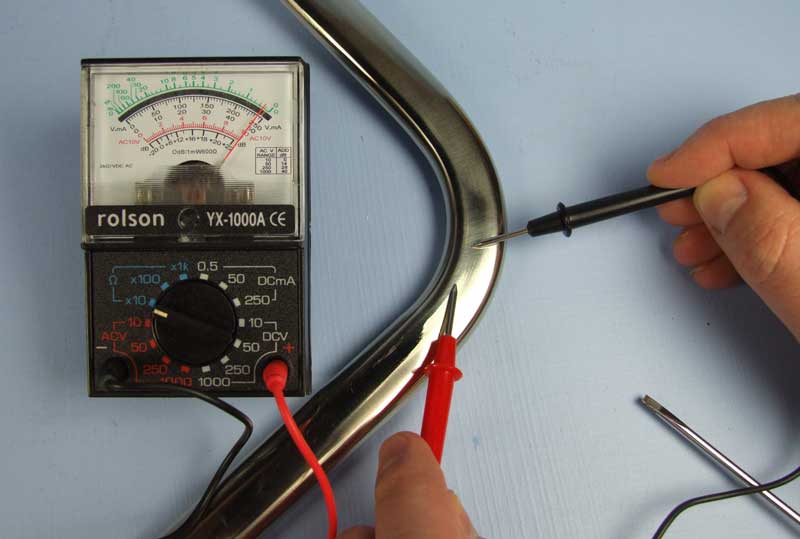
3. Conductivity Tester showing non-conductivity
If, after touching the probes to the surface, there is no movement from the meter needle, this means the surface of your work does not conduct electricity. There may be a number of reasons why this is so;
- there is barrier layer of transparent lacquer on the work
- the work is made of a conductive metal, such as aluminium or titanium
- it’s made of a non-conductive material, such as plastic.
If the first example is the explanation for non-conductivity then the answer is to remove the lacquer with some kind of solvent and then clean it very thoroughly with MPU. If the second, you may have to think again about plating the object. If the third, you can make the surface of non-conductive materials conductive by using our Conductive Ink (hi-grade) or Conductive Paint.
Gold plated contacts for minimum/zero contact resistance – essential when measuring painted conductive coatings.
Duracell batteries for maximum life.
General guide;
Certain small items, for example Swabs, Nibs and Plating Pens can be sent by normal post within the UK
- The courier option for UK deliveries is FedEx
- Free UK mainland delivery available on orders over £200
- International orders usually 3-5 working days.
For all price quotations for deliveries, please add your items to our shopping cart. You will be able to see the shipping costs by clicking on the ‘Calculate shipping’ button in the cart and before checking out.

